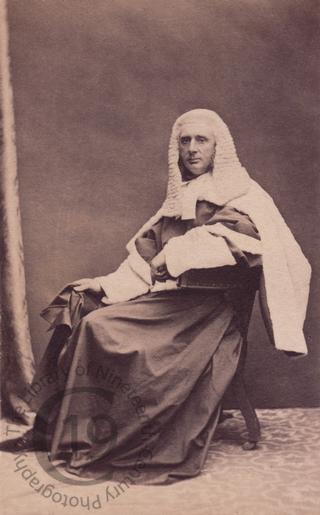
Sir James Wilde, later Lord Penzance
A carte-de-visite portrait of the learned judge Sir James Plaisted Wilde, who sat on the bench of the relatively new Court of Divorce from 1863 until 1872. He was also an amateur gardener of some note and a vociferous proponent of the theory that the works usually attributed to William Shakespeare were in fact written by Francis Bacon.
Born the son of lawyer in 1816, he was the nephew of Lord Chancellor Thomas Wilde, 1st Baron Truro. He became a successful lawyer himself and received a knighthood in 1860. In the same year, he married Lady Mary Pleydell-Bouverie, daughter of the 3rd Earl of Radnor. The couple lived at Eashing Park, Godalming.
Sir James Wilde presided over the Court of Probate and Divorce from 1863 until his retirement in 1872. In 1869, he was created a peer, taking the title 1st Baron Penzance. He came out of retirement in 1875, accepting a post as Dean of Arches and presiding over a number of notorious trials, notably that of Bell, Cox, Dale, Enraght, Green and Tooth, under the Public Worship Regulation Act 1874, a case that concerned the Ritualist controversy in the Church of England.
At his garden in Godalming, from rosa eglanteria and rosa foetida he produced two new roses, named Lady and Lord Penzance. He went on to produce a further fourteen roses, which he named for characters in the novels of Sir Walter Scott.
He argued that the works of Shakespeare are invariably accurate in matters of law and must therefore be the work of a scholar such as Bacon. Lord Penzance inspired others to examine the legal expertise used in Shakespeare, chiefly Sir George Greenwood M.P., who wrote The Shakespeare Problem Revisited.
Lord Penzance died on 9 December 1899.
Photographed by John and Charles Watkins of London.
Code: 125591




